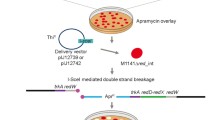Summary
The myxobacteria are among the simplest organisms with a developmental cycle that is dependent on cell cooperation, and they provide an outstanding system with which to study genes involved in cell interactions. Myxococcus xanthus cells which acquire a csg mutation (formerly known as spoC) lose three different traits, the ability to sporulate, the ability to stimulate adjacent Csg cells to sporulate, and the ability to ripple. The boundaries of the csg locus were determined by transferring a recombinant DNA molecule containing all or part of the locus to Csg mutants and examining the sporulation and rippling phenotypes of the transductants. Three methods were used to integrate the csg locus into the chromosome. First, the entire molecule was integrated into the chromosome by a single homologous crossover. Second, a portion of the molecule was integrated into the chromosome by two flanking homologous crossovers. Third, the entire molecule was integrated into the chromosome by site-specific recombination at a bacteriophage attachment site. Together, these techniques suggested that all of the functions of the csg locus are carried on a DNA fragment of 1.9 kbp or less. The locus appears to contain two smaller units of function. Transposon insertions or deletions in the right end of the locus disrupted sporulation and intercellular complementation of Csg mutants for sporulation, but did not disrupt rippling. The intercellular complementation of Csg mutants may reflect a natural and necessary step in the sporulation of wild-type cells, since the ability to sporulate and the ability to stimulate Csg mutants to sporulate were inseparable by any of these methods.
Similar content being viewed by others
References
Casadaban M, Cohen SN (1980) Analysis of gene control signals by DNA fusion and cloning in Escherichia coli. J Mol Biol 138:179–207
Dworkin M, Kaiser D (1985) Cell interactions in myxobacterial growth and development. Science 230:18–24
Feinberg AP, Vogelstein B (1983) A technique for radiolabelling DNA restriction endonuclease fragments to a high specific activity. Anal Biochem 132:6–13
Grunstein M, Hogness D (1975) Colony hybridization: a method for isolation of cloned DNAs that contain a specific gene. Proc Natl Acad Sci USA 72:3961–3965
Hagen DC, Bretscher AP, Kaiser D (1978) Synergism between morphogenetic mutants of Myxococus xanthus. Dev Biol 64:284–296
Hodgkin J, Kaiser D (1977) Cell-to-cell stimulation of motility in nonmotile mutants of Myxococcus. Proc Natl Acad Sci USA 74:2938–2942
Kroos L, Kaiser D (1984) Construction of Tn5 lac, a transposon that fuses lacZ expression to endogenous promoters, and its introduction into Myxococcus xanthus. Proc Natl Acad Sci USA 81:5816–5820
Kroos L, Kuspa A, Kaiser D (1986) A global analysis of developmentally regulated genes in Myxococcus xanthus. Dev Biol 117:252–266
Jorgensen RA, Rothstein SJ, Reznikoff WS (1979) A restriction enzyme cleavage map of Tn5 and location of a region encoding neomycin resistance. Mol Gen Genet 177:65–72
Maniatis T, Fritsch EF, Sambrook J (1982) Molecular cloning: a laboratory manual. Cold Spring Harbor Laboratory Press, New York
O'Conner KA, Zusman DR (1983) Coliphage P1 mediated transfer of DNA from Escherichia coli to Myxococcus xanthus. Use for complementation and recombinational analysis. J Bacteriol 155:317–329
Orndorff PE, Stellwag E, Starich T, Dworkin M, Zissler J (1983) Genetic and physical characterization of lysogeny by bacteriophage Mx8 in Myxococcus xanthus. J Bacteriol 154:772–779
Reichenbach H (1965) Rhythmische Vorgänge bei der Schwarmentwicklung von Myxobakterien. Berl Dtsch Bot Ges 78:102–105
Reichenbach H, Heunert HH, Kuczka H (1965) Schwarmentwicklung und Morphogenese bei Myxobakterien-Archangium, Myxococcus, Chondrococcus, Chondromyces. Film C893, Inst F Wissen, Film. Gottingen, Germany
Shimkets LJ (1987) Control of morphogenesis in myxobacteria. CRC Crit Rev Microbiol 14:195–227
Shimkets LJ, Kaiser S (1982a) Induction of coordinated movement of Myxococcus xanthus cells. J Bacteriol 152:451–461
Shimkets LJ, Kaiser D (1982b) Murien components rescue developmental sporulation of Myxococcus xanthus. J Bacteriol 152:462–470
Shimkets LJ, Gill RE, Kaiser D (1983) Developmental cell interactions in Myxococcus xanthus and the spoC locus. Proc Natl Acad Sci USA 80:1406–1410
Stellwag E, Fink JM, Zissler J (1985) Physical characterization of the genome of the Myxococcus xanthus bacteriophage Mx8. Mol Gen Genet 199:123–132
Sternberg N, Hoess R (1983) The molecular genetics of bacteriophage P1. Annu Rev Genet 17:123–154
Youngman P, Zuber P, Perkins JB, Sandman K, Igo M, Losick R (1985) New ways to study developmental genes in sporeforming bacteria. Science 228:285–291
Author information
Authors and Affiliations
Additional information
Communicated by N.D.I. Grindley
Rights and permissions
About this article
Cite this article
Shimkets, L.J., Asher, S.J. Use of recombination techniques to examine the structure of the csg locus of Myxococcus xanthus . Mol Gen Genet 211, 63–71 (1988). https://doi.org/10.1007/BF00338394
Received:
Issue Date:
DOI: https://doi.org/10.1007/BF00338394




